Can the British summer charge a Garmin Edge 1040 Solar?
Despite the clouds it does better than perhaps you might expect...
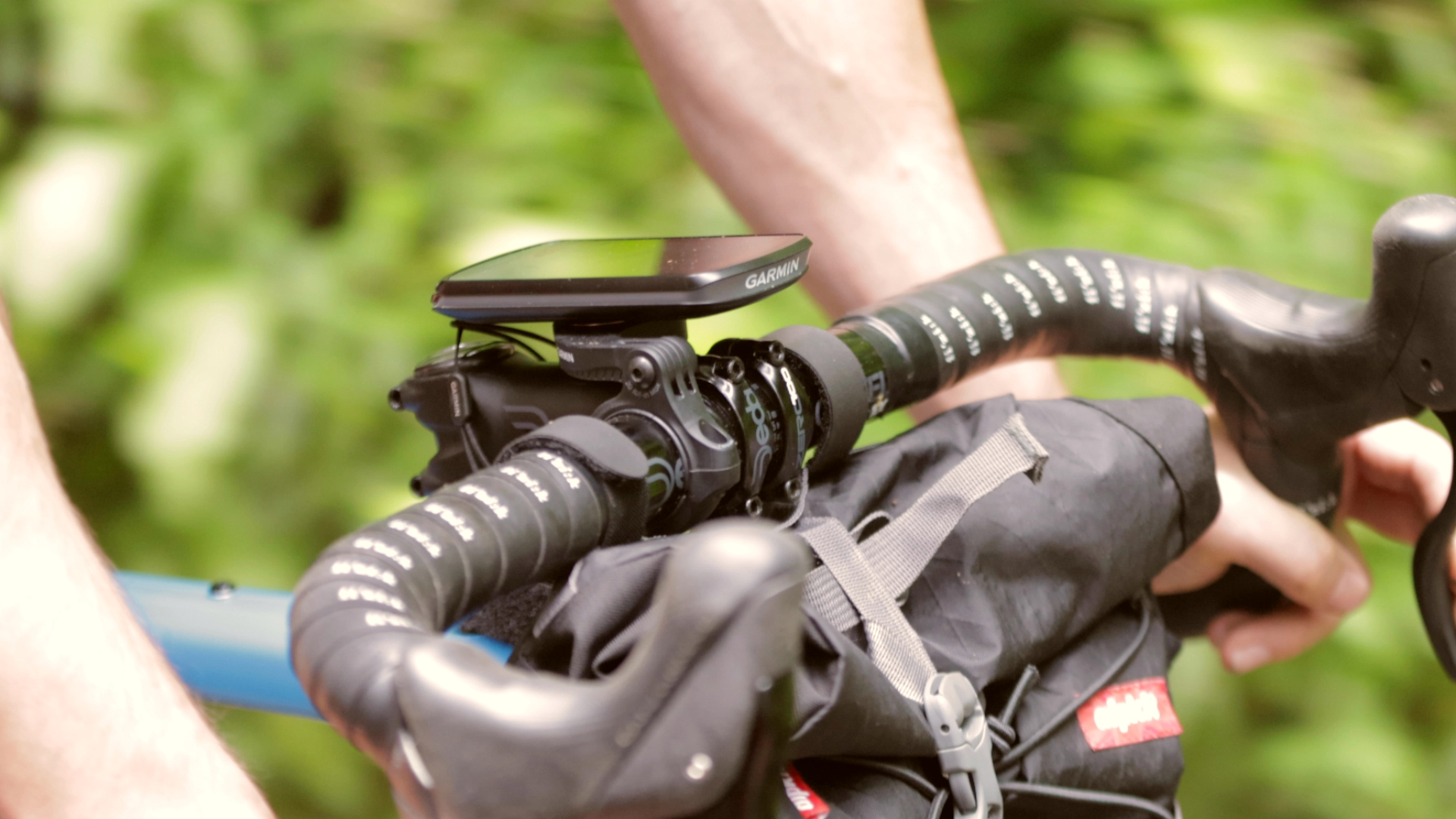

We've heard what Garmin's claims are for the Edge 1040 Solar's photovoltaic performance – it can add around 20 minutes of charge for every hour of riding.
But we'll take a punt and suggest that this estimation probably isn't based on the average riding conditions in the cloudy, rainy and cool British Isles (and that's just the summer).
So just how well does Garmin's Solar technology perform in this less-than-ideal climate? We've taken a unit for a variety of rides ,with a range of weather conditions, ride durations and at various times of day and pulled together the data.
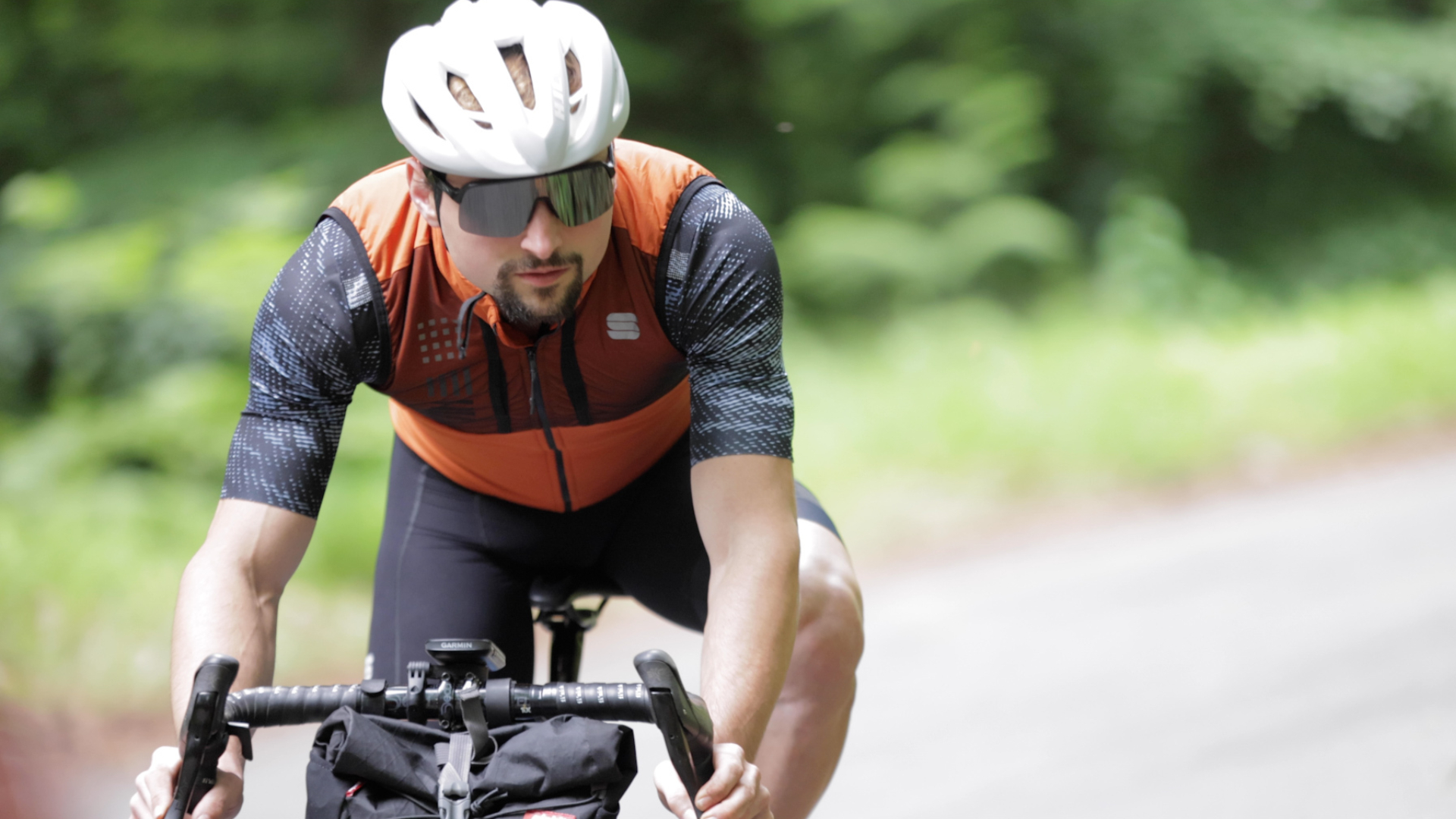
We're going to be focusing only on the solar performance here. If you're after a rundown of all the tech specs, you can pop over to our launch story on the Garmin Edge 1040 Solar. Or, you can head over here if you're looking for our full first ride review of the Garmin 1040 Solar.
Down below, we've got six rides with charts displaying the ride duration and start time, as well as the actual solar power gained contrasted to the theoretical potential. With each, there's a description and analysis of the ride's conditions and then we sum up with a verdict at the end. Let's dig in.
Ride 1
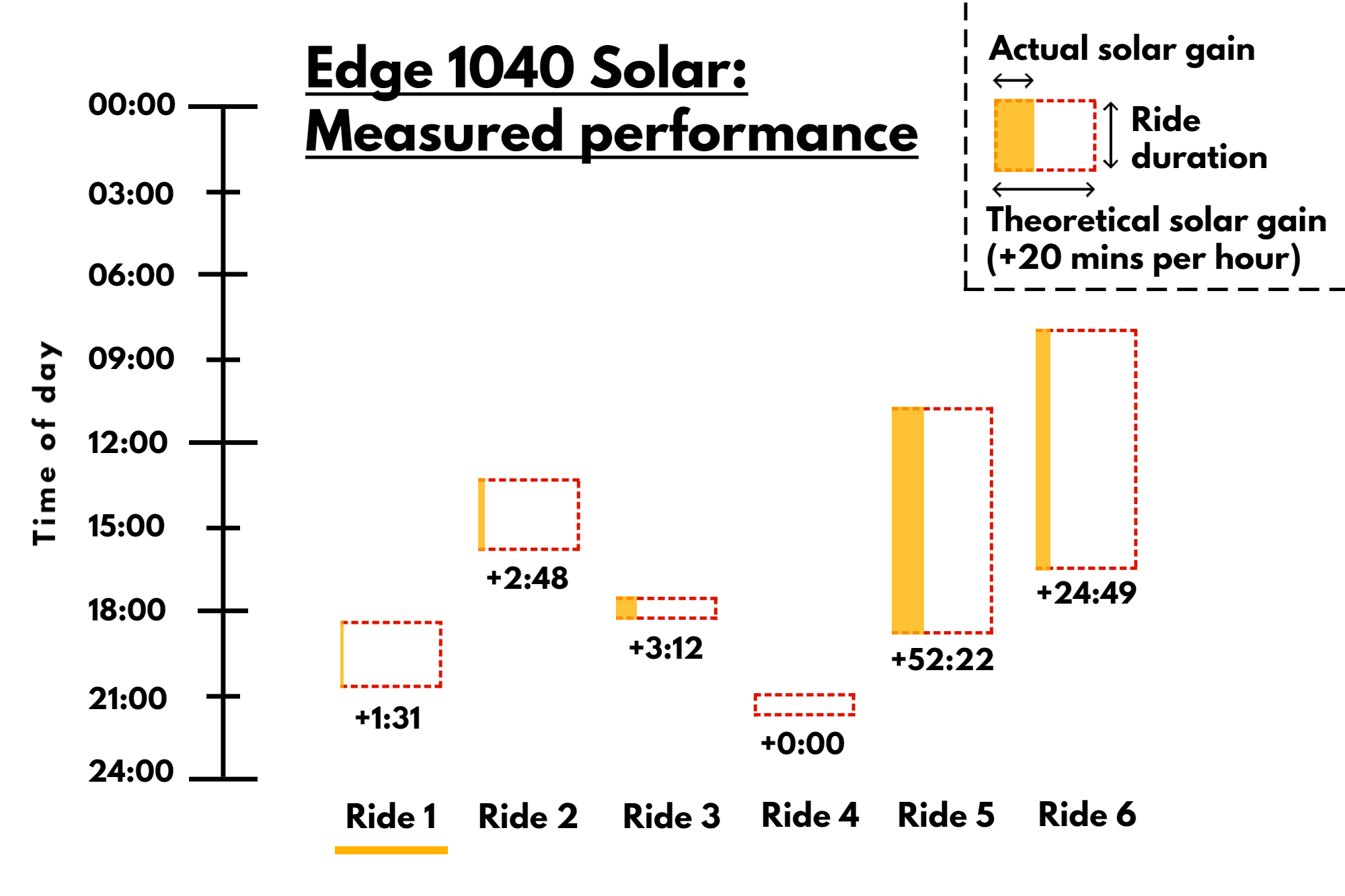
Weather: cloudy | Start time: 18:11 | Ride time: 2:23:31 | Battery gain: 0:01:31
On this first ride I got out quite late in the day, near to sunset and under cloudy skies. I wasn't expecting to gain a lot of charge and, sure enough, I didn't.
One minute and 31 seconds of battery gain over almost two and a half hours is a far cry less than the potential +20 minutes per every hour of riding. In fact, the charge I gain works out as about three per cent of that theoretical amount – so hardly anything at all.
But, as I mentioned, thanks to the conditions, this wasn't much of a surprise.
Ride 2
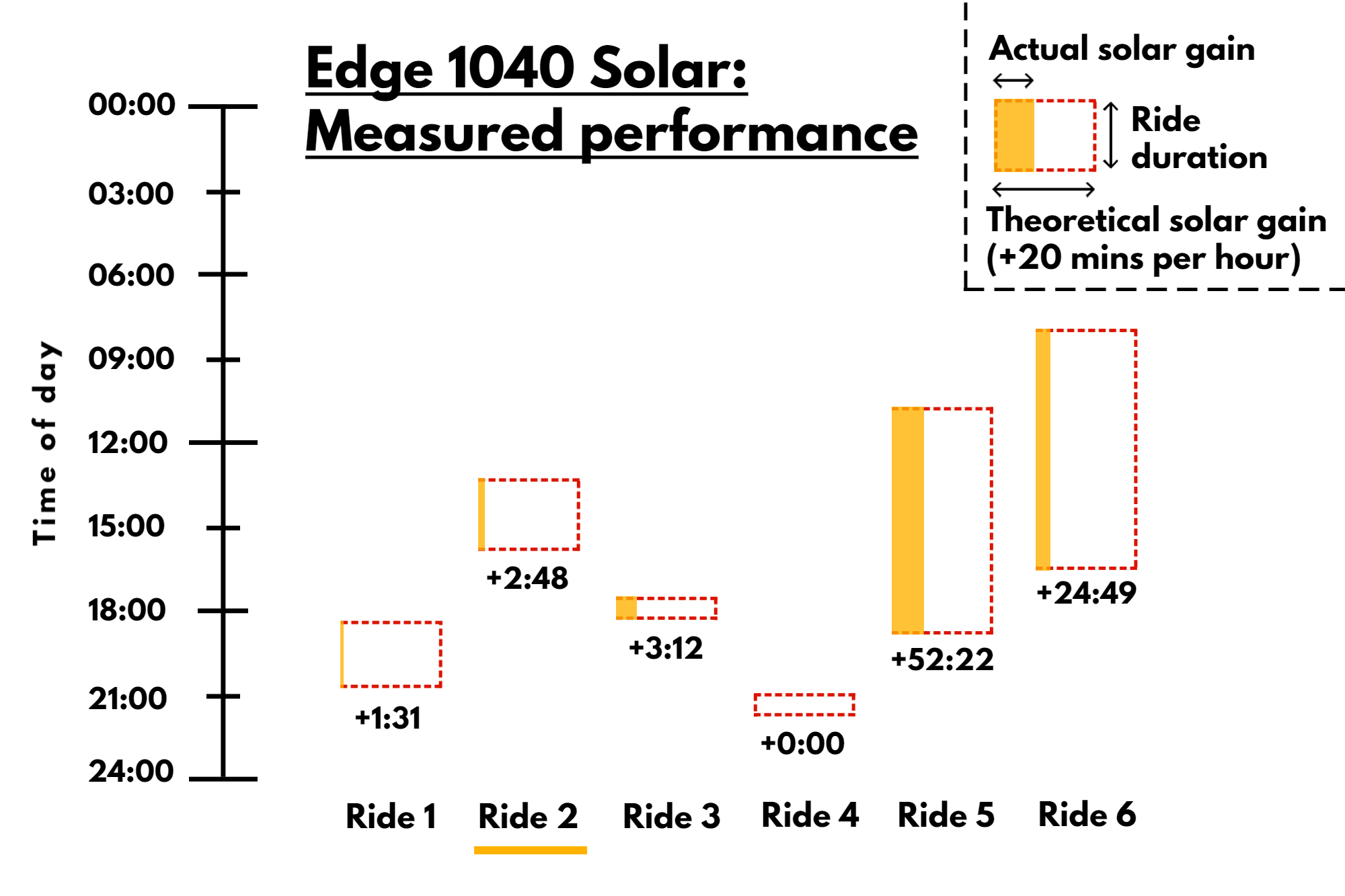
Weather: very cloudy | Start time: 13:20 | Ride time: 2:01:40 | Battery gain: 0:02:48
Particularly in comparison to my first ride, I was very interested to see the amount of battery gain from this one.
Thanks to daylight saving time (and being so far west of London) the sun reaches its zenith around me at about 13:11. As a result, my ride started only just after the sun was at its strongest.
On the other hand, the clouds were about as thick and dark as they could possibly be without actually breaking into rain. To be honest, I was quite surprised they didn’t.
Looking at the charge gained it seems that the midday sun – albeit behind thick clouds – is more effective at charging than the weak evening sun, even if the cloud cover isn't quite as thick.
Still, the amount of charge I gained was about seven per cent of the theoretical +20 mins/hour, so still not that much.
Ride 3
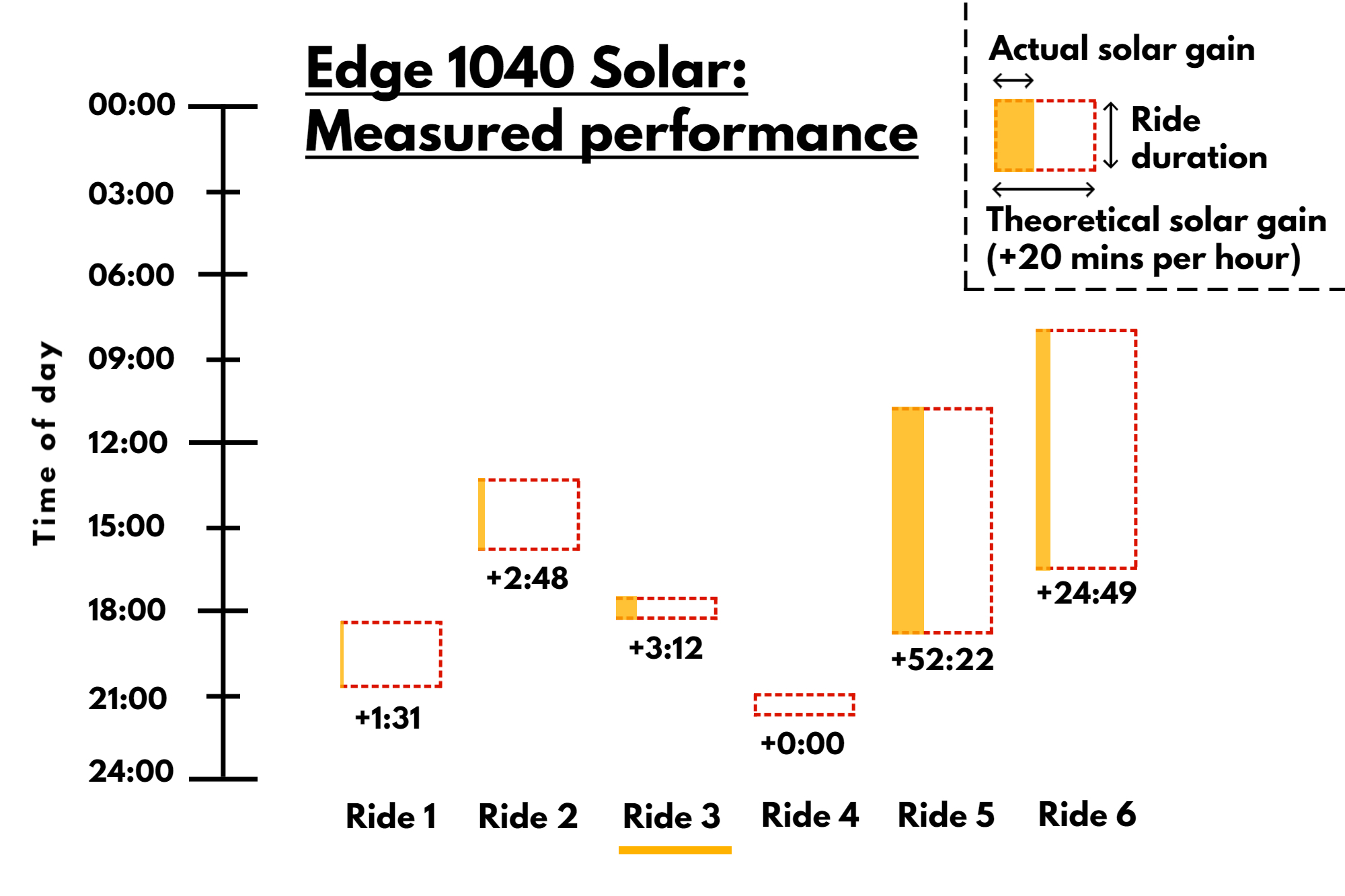
Weather: mostly sunny | Start time: 17:45 | Ride time: 0:45:35 | Battery gain: 0:03:12
This ride made another interesting contrast. Only a little earlier in the day than my first, but instead mostly sunny with only a few clouds in the sky.
The amount of charge I gained was significantly better than both riding around midday with heavy cloud (ride 2) and riding on a more averagely cloudy evening (ride 1).
But it still fell some way short of the +20mins/hour mark. Doing the calculations, the charge I gained was about 21 per cent of that amount.
Ride 4
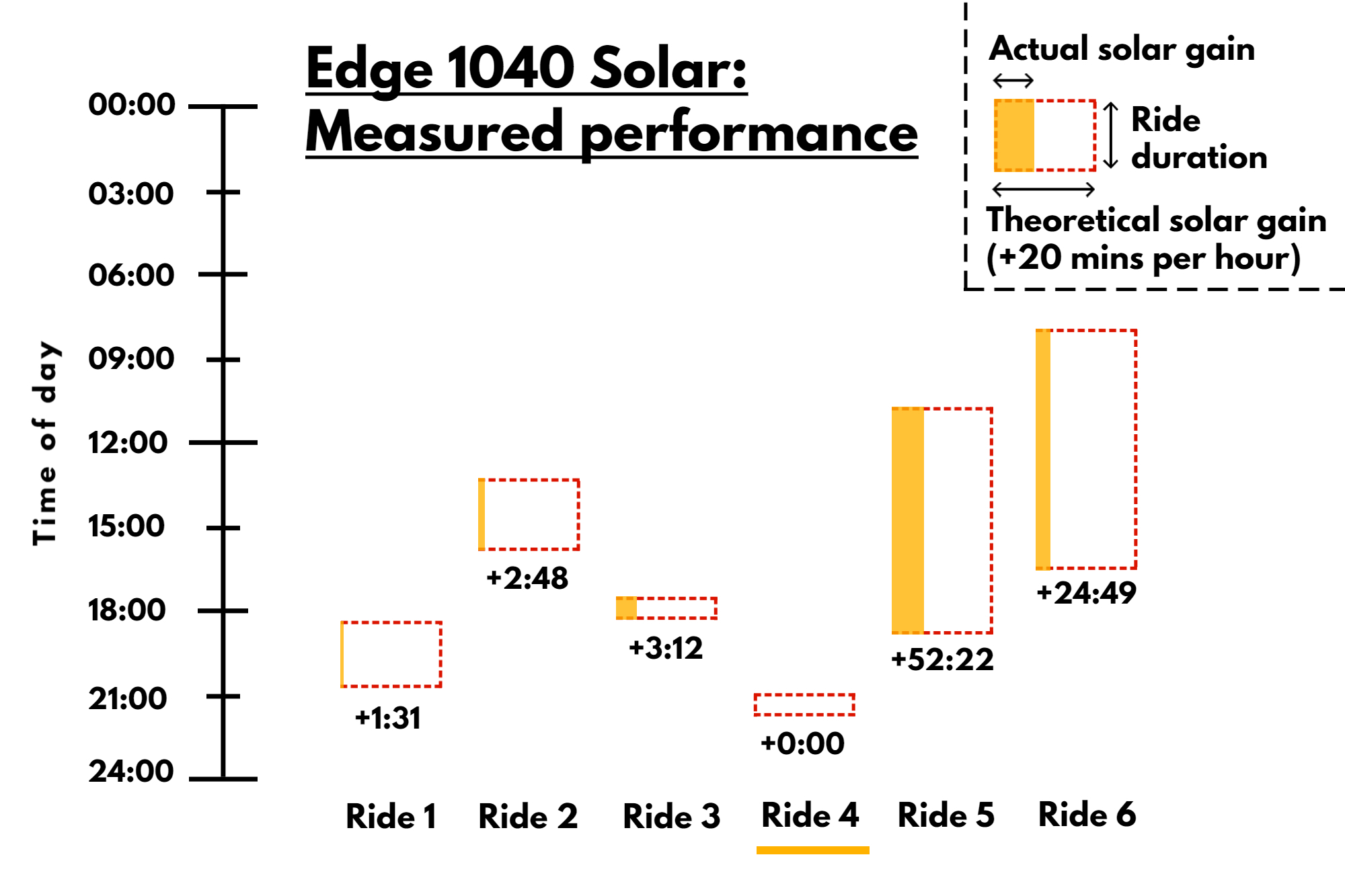
Weather: sunny | Start time: 20:47 | Ride time: 0:48:27 | Battery gain: 0:00:00
This was actually later on during same day as ride 3. The few clouds that were previously around had cleared off, leaving the sun blindingly bright and sitting low on the horizon.
Given that I still had about 30 mins before sunset, I was expecting a little more charge than literally zero.
But looking back, the rays would have been hitting the unit at a pretty acute angle, rather than being close to dead on. And, although it certainly felt like the sun was constantly in my eyes, the truth is it probably was hidden behind houses and the hills for most of it.
Even so, to not gain a second was a surprise.
Ride 5
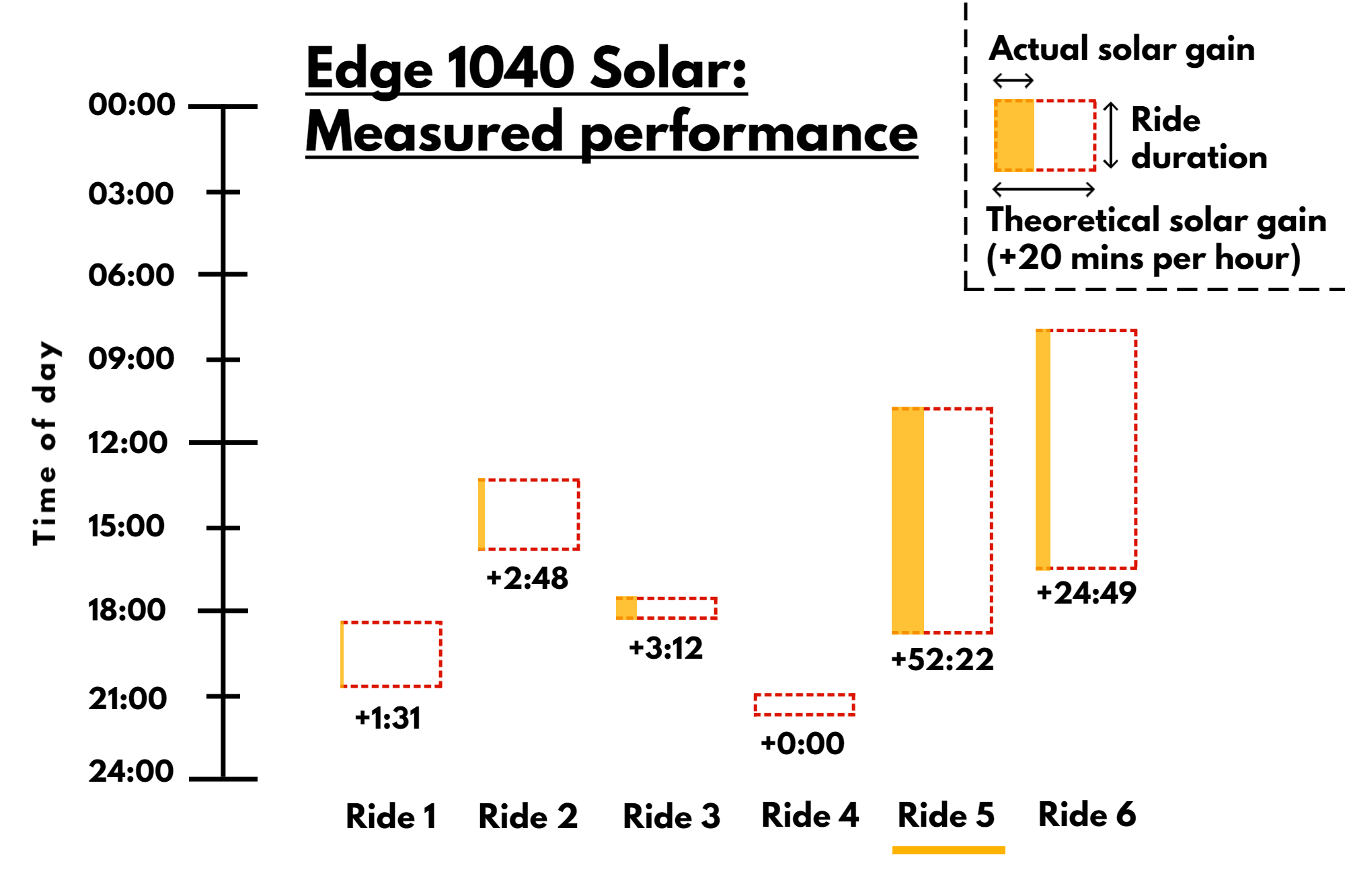
Weather: sunny then rain | Start time: 09:25 | Ride time: 8:05:49 | Battery gain: 0:52:22
For the first half of this ride, the weather was largely sunny with just a few clouds. Later on, it turned dark and intermittently showered for the rest of the day.
The amount of charge I gained wasn’t only much greater in absolute terms – nearly hitting an hour – but that also equated to about 32 per cent of the potential +20mins/hour, which is the highest I’ve gotten.
This shows, perhaps not so surprisingly, that rather gaining than a steady rate of charge throughout the day, the solar power swings between extremes. Lots of charge is gained around midday and in the full sun; substantially less is gained at other times and conditions.
If you miss the peak times, you just aren't going to gain much that day.
The other point to note is just how efficient the Edge 1040 Solar is. Less than an hour’s extra ride time gained isn’t really that much, but at the end of ride I was still on 91 per cent of full charge – which was highly impressive.
Ride 6
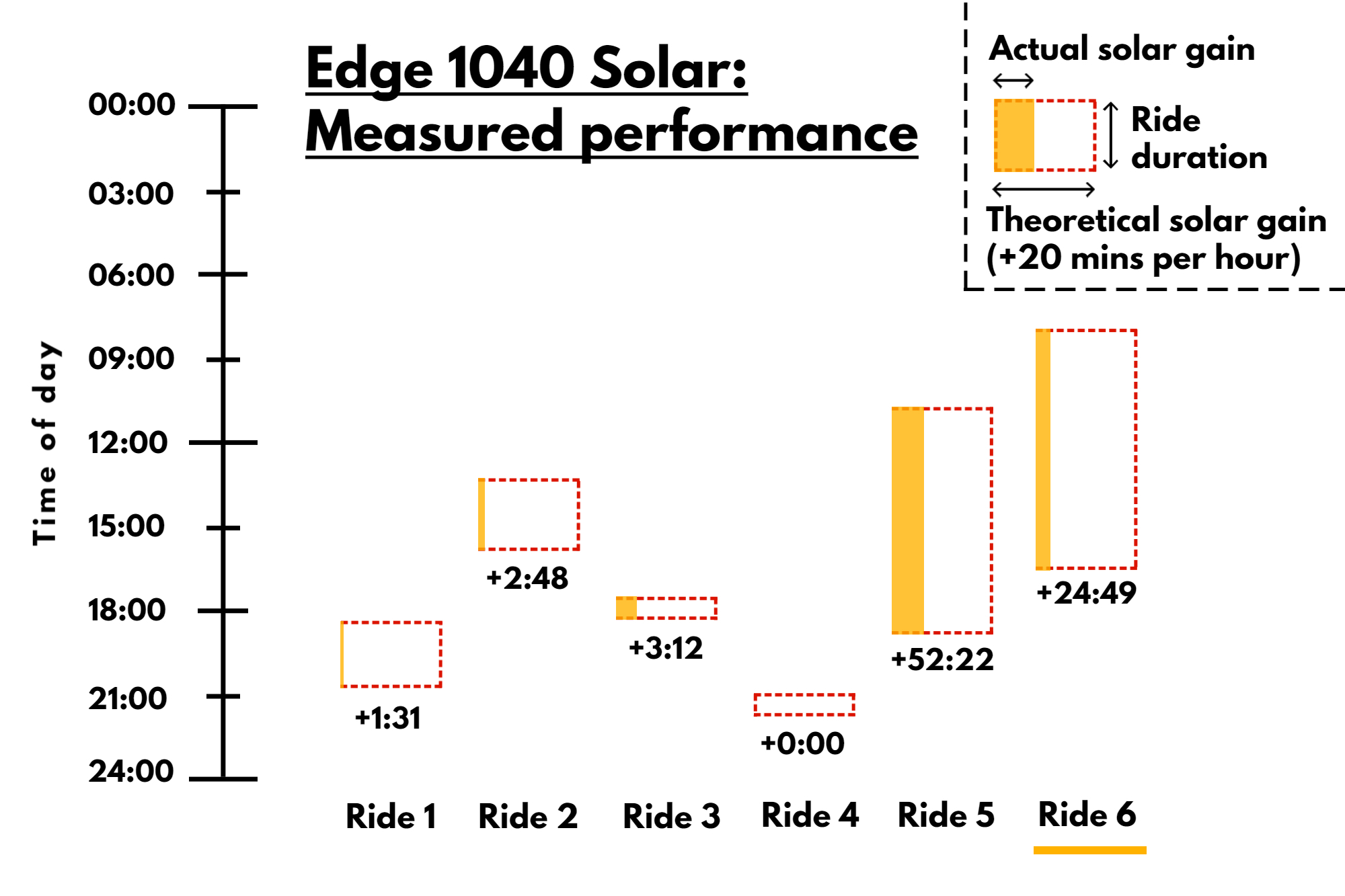
Weather: persistent drizzle | Start time: 07:11 | Ride time: 8:40:01 | Battery gain: 0:24:49
Following up with a longer ride which started earlier in the day, you might have thought I’d end up with more charge than on the previous outing – not so.
Again, just underlining the importance of direct sunlight (preferably around midday), the persistent drizzle and pretty blanket cloud cover meant I ended up with just half the charge time as in ride 5.
One final point to make is that on all these rides I had the screen on auto brightness, a route loaded and the map page constantly showing, a HRM and power meter connected and the GPS on its medium accuracy setting. I wasn't exactly trying to maximise the battery life.
Still, ride 6 followed ride 5 without me adding any extra charge . After that first day I was down to 91 per cent; I finished ride 6 on 76 per cent.
Verdict
So, what to make of all this?
First is that you’re not going to be getting a whole lot of charge riding in the UK – especially if you’re cramming your rides in before and after work. Arguably, this isn’t much of a problem, you wouldn’t be at risk of draining your battery on those rides, although it would mean you'd have charge it with a cable close to as much as you would without the Solar tech.
The main benefit is on long, all-day rides. I found the battery life extremely impressive and would have been even better had it not been so cloudy.
Of course, there is the question of whether it’s really worth buying the Edge 1040 Solar or simply using a smartphone or standard head unit with a charger pack – either of these would be a much cheaper setup.
But each does have its own issues. Cheap phones don’t tend to be waterproof and protective cases are bulky – especially those designed to be protective while still permitting charging.
A similar issue with charging in the wet crops up when combining a head unit with a battery pack. Although with the speed of charging a head unit and the longer battery life compared to a phone, it should be a little easier to juggle charging with the rain.
The Edge 1040 Solar does offer a simpler and cleaner solution than either of those options. Whether this is worth the (hefty) price will ultimately be a personal choice.
Perhaps a rule of thumb could be that a reasonable price to spend on a headunit is about twice that of your cycling shoes. A pair of workhorse Shimano RC5 road shoes is a little over half that of a Garmin Edge 530; most S-Works kicks would easily justify splashing out on the Edge 1040 Solar by the same measure.
For me, if was given the choice of any head unit, I probably would choose the Edge 1040 Solar. But if I was given fixed budget to balance across a bike, clothing and any accessories, I’d probably go with either the Hammerhead Karoo 2 or the Garmin Edge 530.
We'll continue putting miles into the Edge 1040 Solar, so stay tuned (or perhaps tune back in) for our long-term review.

Thank you for reading 20 articles this month* Join now for unlimited access
Enjoy your first month for just £1 / $1 / €1
*Read 5 free articles per month without a subscription

Join now for unlimited access
Try first month for just £1 / $1 / €1
Get The Leadout Newsletter
The latest race content, interviews, features, reviews and expert buying guides, direct to your inbox!

After winning the 2019 National Single-Speed Cross-Country Mountain Biking Championships and claiming the plushie unicorn (true story), Stefan swapped the flat-bars for drop-bars and has never looked back.
Since then, he’s earnt his 2ⁿᵈ cat racing licence in his first season racing as a third, completed the South Downs Double in under 20 hours and Everested in under 12.
But his favourite rides are multiday bikepacking trips, with all the huge amount of cycling tech and long days spent exploring new roads and trails - as well as histories and cultures. Most recently, he’s spent two weeks riding from Budapest into the mountains of Slovakia.
Height: 177cm
Weight: 67–69kg
-
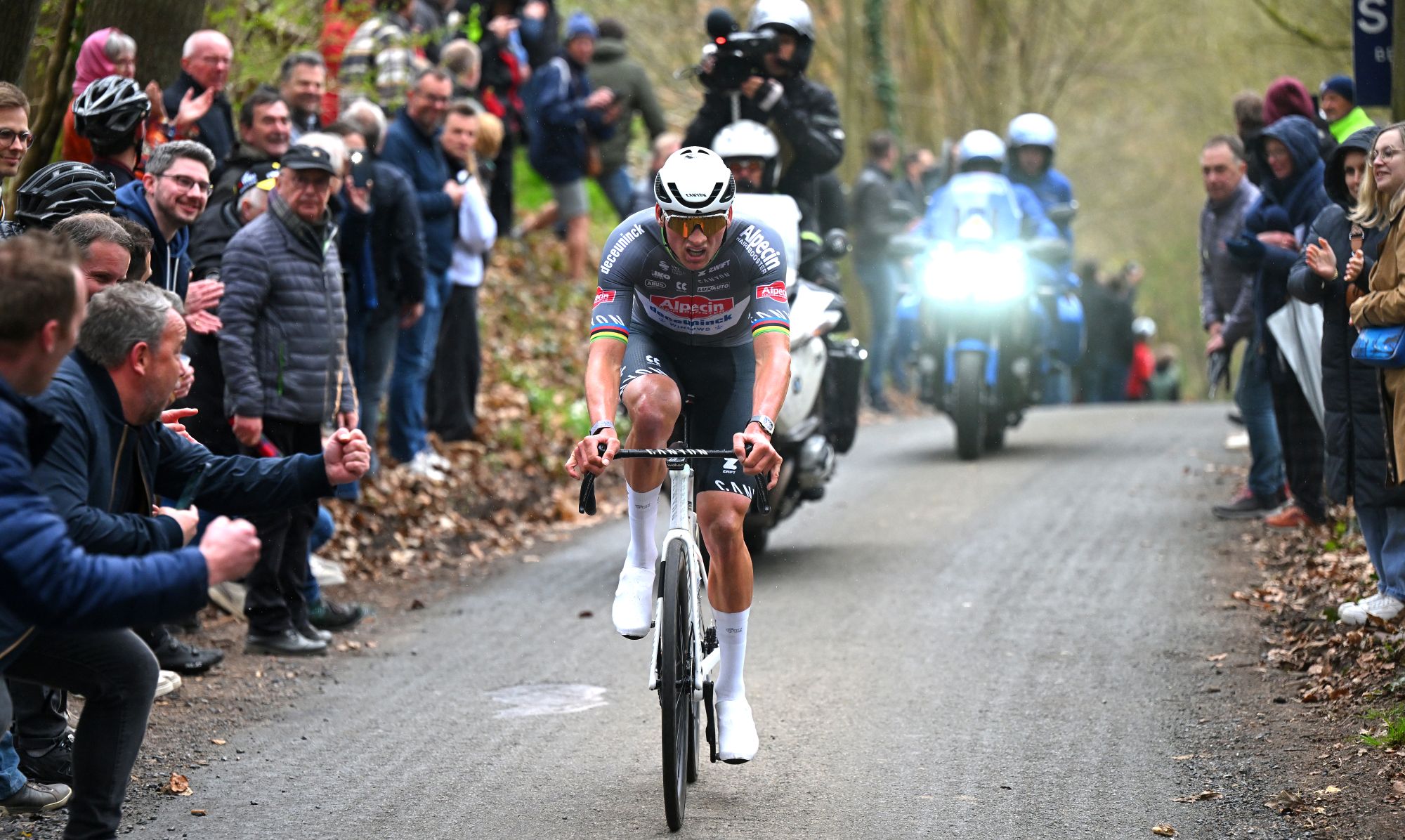 'I start every race to win' - Mathieu van der Poel fired up ahead of Paris-Roubaix showdown with Tadej Pogačar
'I start every race to win' - Mathieu van der Poel fired up ahead of Paris-Roubaix showdown with Tadej PogačarTwo-time winner says he has suffered with illness during spring Classics campaign
By Tom Thewlis Published
-
 'It's really surreal that now I'm part of it' - 19-year-old Imogen Wolff set to go from spectator to racer at Paris-Roubaix
'It's really surreal that now I'm part of it' - 19-year-old Imogen Wolff set to go from spectator to racer at Paris-RoubaixBrit first came to see the 'Hell of the North' when she was six
By Tom Davidson Published